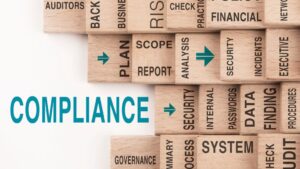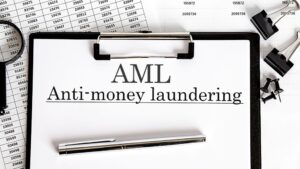Introduction to AML Compliance Controls
To combat the risks associated with money laundering, terrorist financing, and other financial crimes, financial institutions and businesses are required to adhere to strict anti-money laundering (AML) regulations. AML compliance controls play a crucial role in ensuring that organizations have robust systems and processes in place to detect and prevent illicit activities. In this section, we will explore the fundamental aspects of AML compliance and the importance of implementing effective AML compliance controls.
Understanding AML Compliance
AML compliance refers to the measures and procedures put in place by financial institutions and businesses to identify, assess, and mitigate the risks associated with money laundering and other financial crimes. The goal of AML compliance is to prevent criminals from using legitimate financial systems to disguise the origins of illicit funds. By implementing comprehensive AML compliance controls, organizations can contribute to the global fight against financial crimes and maintain the integrity of the financial system.
AML compliance involves several key components, including customer due diligence (CDD), suspicious activity monitoring and reporting, and the establishment of policies, procedures, and training programs. These controls ensure that organizations have a holistic approach to identifying and mitigating risks associated with money laundering and other illicit activities.
Importance of AML Compliance Controls
The consequences of non-compliance with AML regulations can be severe, both financially and operationally. Financial penalties and fines imposed by regulatory bodies can result in significant financial losses for organizations. For example, Goldman Sachs was fined a staggering $2.9 billion for its involvement in the 1MDB scandal, which violated AML and corruption regulations. These fines can vary depending on the extent of the violation, the harm caused, and the jurisdiction (Source).
Non-compliance with AML regulations can also have operational and reputational implications. Remediation efforts to rectify non-compliance, such as system improvements, retraining staff, or implementing new technologies, come with a financial cost. Additionally, financial institutions may face class-action lawsuits from shareholders or customers, leading to further financial payouts. The suspension of certain business activities or the revocation of licenses can also directly impact an institution’s revenue, and in severe cases, non-compliance can even put an organization out of business (Source).
By implementing effective AML compliance controls, organizations can not only meet regulatory requirements but also protect themselves from these significant financial and operational risks. A robust AML compliance program ensures that organizations have the necessary systems, procedures, and training in place to detect, prevent, and report suspicious activities. This helps maintain the integrity of the financial system and safeguards organizations from the legal and reputational consequences of non-compliance.
In the following sections, we will delve deeper into the key components of an AML compliance program, the utilization of technology for AML compliance, as well as regulatory requirements related to AML compliance controls.
Consequences of Non-Compliance with AML Regulations
Ensuring compliance with Anti-Money Laundering (AML) regulations is of paramount importance for financial institutions and businesses to mitigate the risk of financial crimes. Non-compliance with AML regulations can have severe consequences, including financial penalties and fines, as well as operational and reputational implications.
Financial Penalties and Fines
Non-compliance with AML regulations can result in significant financial penalties imposed by regulatory bodies. The fines can vary depending on the extent of the violation, the harm caused, and the jurisdiction. Financial institutions may face hefty fines as a result of AML non-compliance, which can range from thousands to millions of dollars.
For example, in the infamous 1MDB scandal, Goldman Sachs was fined a staggering $2.9 billion for its involvement, which violated AML and corruption regulations (Source). These penalties serve as a deterrent for organizations to prioritize AML compliance and implement effective controls.
Operational and Reputational Implications
Non-compliance with AML regulations can have significant operational implications for financial institutions and businesses. Remediation efforts to rectify AML non-compliance, such as improving internal systems, retraining staff, hiring additional compliance personnel, or implementing new technologies, come with a financial cost. The need for heavy investment in remediating issues can disrupt business operations and strain resources (Source).
Operational implications may also extend to the suspension of certain business activities or the revocation of licenses. In severe cases, non-compliance can put an institution out of business, leading to significant revenue loss (Source).
Furthermore, non-compliance with AML regulations can have severe reputational implications. It can damage an institution’s public image, erode customer trust, strain relationships with other banks and institutions, and attract increased scrutiny from regulators. Rebuilding a tarnished reputation can be a long and arduous process, impacting an institution’s ability to attract and retain customers (Source).
To avoid these dire consequences, financial institutions and businesses must prioritize the implementation of robust AML compliance controls. These controls encompass various components, such as customer due diligence, suspicious activity monitoring and reporting, and comprehensive policies, procedures, and training (aml policy and procedures, aml compliance training). Additionally, leveraging technology, such as AML automation and AI, can enhance the effectiveness and efficiency of AML compliance programs (aml compliance software).
By implementing and maintaining strong AML compliance controls, organizations can safeguard against financial penalties, operational disruptions, and reputational damage. Compliance with AML regulations not only protects institutions from legal and financial repercussions but also helps maintain the integrity of the global financial system.
Key Components of an AML Compliance Program
To fortify financial security and combat money laundering and other financial crimes, it is crucial for organizations to establish a robust Anti-Money Laundering (AML) compliance program. Such a program comprises several key components that work together to ensure adherence to AML regulations and international standards. Let’s explore three essential components of an effective AML compliance program: Customer Due Diligence (CDD), Suspicious Activity Monitoring and Reporting, and Policies, Procedures, and Training.
Customer Due Diligence (CDD)
Customer Due Diligence (CDD) is a fundamental component of an AML compliance program. It involves conducting thorough background checks on customers to verify their identities, assess their risk levels, and evaluate the legitimacy of their transactions. CDD measures are essential for detecting and preventing money laundering and terrorist financing activities.
During the CDD process, financial institutions and other regulated entities must gather relevant information about their customers, such as their identity, occupation, source of funds, and beneficial ownership. This information helps in assessing the potential risk associated with the customer and their transactions.
By implementing CDD measures, organizations can effectively identify and categorize high-risk customers, such as politically exposed persons (PEPs) and individuals from high-risk countries. This enables them to tailor their risk mitigation strategies and allocate resources accordingly. Regularly updating customer information and conducting ongoing due diligence are vital to maintain the effectiveness of CDD measures.
Suspicious Activity Monitoring and Reporting
Suspicious Activity Monitoring and Reporting is another critical component of an AML compliance program. It involves the continuous monitoring of customer transactions and activities to identify any suspicious patterns or red flags that may indicate potential money laundering or illicit financial activities.
Financial institutions and regulated entities must have robust systems in place to monitor transactions, flag suspicious activities, and promptly report them to the appropriate authorities, such as the financial intelligence unit (FIU). By diligently monitoring customer behavior and transactional activities, organizations can detect and report suspicious activities in accordance with FATF recommendations.
Automated systems, leveraging advanced technologies such as artificial intelligence (AI) and machine learning, can enhance the effectiveness of suspicious activity monitoring. These systems can analyze vast amounts of data, identify unusual patterns, and generate alerts for further investigation. Implementing such technology can significantly streamline the monitoring and reporting process, improving the overall efficiency of AML compliance efforts.
Policies, Procedures, and Training
Establishing and implementing comprehensive written policies, procedures, and training programs is crucial for ensuring AML compliance. These policies and procedures should cover all aspects of AML compliance, including customer onboarding, transaction monitoring, reporting obligations, and record-keeping requirements.
The policies and procedures should be easily accessible to relevant personnel, such as relationship managers and financial sales representatives, to ensure consistent adherence to AML compliance standards. Regular training sessions should be conducted to educate employees about the latest regulatory requirements, emerging money laundering typologies, and best practices for identifying and reporting suspicious activities.
By having well-defined policies, procedures, and training programs, organizations can create a culture of compliance, ensuring that employees understand their roles and responsibilities in maintaining AML compliance. Regular audits and program assessments can help identify any gaps or weaknesses in the AML compliance framework, allowing for timely remediation and continuous improvement.
In conclusion, a robust AML compliance program requires the integration of key components such as Customer Due Diligence (CDD), Suspicious Activity Monitoring and Reporting, and Policies, Procedures, and Training. By implementing these components effectively, organizations can enhance their ability to detect and prevent money laundering and other financial crimes, thereby fortifying financial security and maintaining regulatory compliance.
Utilizing Technology for AML Compliance
In the ever-evolving landscape of anti-money laundering (AML) compliance, integrating technology has become essential for effective controls. One of the key technological advancements in this field is the automation of AML processes, leveraging artificial intelligence (AI) to enhance detection and prevention capabilities.
AML Automation and AI
AML automation refers to the use of AI and machine learning to streamline compliance tasks related to customers and transactions. By automating these processes, financial institutions can detect suspicious activities more efficiently, reducing the reliance on manual screening and checking. AI-powered systems can process large volumes of data in real time, improving accuracy and reducing the risk of human error.
AI has emerged as a powerful tool in transforming AML compliance processes, revolutionizing how financial institutions detect and prevent money laundering. AI integrated into AML controls advanced capabilities such as natural language processing, machine learning, and pattern recognition. These technologies provide real-time insights into potential risks, enabling institutions to take proactive measures to combat money laundering.
Benefits of Automating AML Compliance
Automating AML compliance with AI brings numerous benefits to financial institutions. One of the key advantages is the significant boost in accuracy and efficiency. AI-powered systems can process large amounts of data in real time, reducing human error and false positives. By leveraging machine learning algorithms, AI continuously learns and improves its detection capabilities, adapting to evolving money laundering techniques and patterns (KYC2020).
AI-driven automation enhances risk assessment and detection capabilities by identifying complex relationships, network connections, and behavioral anomalies that may indicate money laundering or other illicit activities. Real-time monitoring and alerts enable timely intervention, minimizing potential risks and facilitating proactive compliance measures (KYC2020).
Furthermore, automating AML compliance with AI leads to cost and resource optimization. By reducing manual processes, organizations can allocate their workforce to higher-value tasks and efficiently handle large volumes of data. This eliminates the need for additional staffing and reduces operational costs (KYC2020).
Incorporating technology and AI into AML compliance controls has become imperative for financial institutions. The use of automation streamlines processes, improves detection capabilities, and optimizes resource allocation. By embracing these technological advancements, organizations can enhance their AML compliance programs and stay ahead in the fight against money laundering and financial crime.
AML Compliance Controls and Regulatory Requirements
To ensure effective Anti-Money Laundering (AML) compliance, financial institutions and firms must implement robust AML compliance controls that align with regulatory requirements. Two key aspects of AML compliance controls are the FINRA AML Compliance Tools and the BSA/AML Compliance Program.
FINRA AML Compliance Tools
The Financial Industry Regulatory Authority (FINRA) provides member firms with various AML compliance tools to facilitate regulatory compliance. These tools aim to support member firm compliance professionals in their day-to-day activities and reporting requirements.
The FINRA Gateway serves as a platform for member firm compliance professionals to access filings, submit support tickets, and run reports. It provides a centralized hub for managing AML compliance activities within member firms.
FINRA Data offers non-commercial use of data and allows compliance professionals to save data views. It also provides the capability to create and manage a Bond Watchlist for public use, aiding in compliance monitoring (FINRA AML FAQ).
FinPro caters to industry professionals, such as registered representatives, enabling them to meet Continuing Education requirements, view their CRD record, and conduct other compliance tasks (FINRA AML FAQ).
The DR Portal serves case participants in arbitration and mediation, as well as FINRA neutrals. It allows them to view case information and submit documents through the Dispute Resolution Portal, streamlining compliance processes (FINRA AML FAQ).
These FINRA AML compliance tools enhance the efficiency and effectiveness of AML compliance controls for member firms, helping them meet regulatory requirements and maintain strong compliance programs.
BSA/AML Compliance Program
The Bank Secrecy Act (BSA) and Anti-Money Laundering (AML) regulations require financial institutions, including banks, to establish and maintain a comprehensive BSA/AML Compliance Program. This program must incorporate various components to ensure effective AML compliance, as outlined in the BSA/AML Manual.
Key aspects of a BSA/AML Compliance Program include:
Customer Due Diligence (CDD): The program must have a robust customer identification program (CIP) with risk-based procedures for verifying customers’ identities. Ongoing customer due diligence and compliance with beneficial ownership requirements for legal entity customers are also crucial (BSA/AML Manual).
Suspicious Activity Monitoring and Reporting: Financial institutions must establish systems and processes to monitor and detect suspicious activities. Timely reporting of suspicious transactions to the appropriate authorities is essential to combat money laundering and other illicit financial activities.
Policies, Procedures, and Training: A comprehensive BSA/AML Compliance Program should include written policies and procedures that cover all aspects of AML compliance. Regular training programs should be conducted to ensure employees are aware of their responsibilities and remain up to date with the evolving AML landscape.
It is essential for financial institutions to align their AML compliance controls with these regulatory requirements. Regular assessments of the BSA/AML Compliance Program, as well as thorough examination findings, help ensure ongoing compliance and identify areas for improvement (BSA/AML Manual). By adhering to these requirements, financial institutions can strengthen their AML compliance controls and mitigate the risks associated with money laundering and other illicit financial activities.
Enhancing AML Compliance Controls
To strengthen anti-money laundering (AML) compliance efforts, financial institutions must continuously assess and enhance their AML compliance controls. This involves conducting regular evaluations of the AML compliance program and utilizing specialized platforms to streamline processes and improve efficiency.
AML Compliance Program Assessment
Regularly assessing the effectiveness of an AML compliance program is essential for identifying areas that need improvement and ensuring compliance with AML regulations. An AML compliance program assessment involves a comprehensive review of all aspects of the program, including policies, procedures, training, and internal controls.
Key components of an AML compliance program assessment may include:
Suspicious Activity Monitoring and Reporting Evaluation: Evaluating the effectiveness of the suspicious activity monitoring and reporting systems to ensure they are capable of detecting and reporting potential money laundering and terrorist financing activities. This assessment helps identify any gaps in the system and allows for necessary enhancements to be made.
Customer Due Diligence (CDD) Review: Reviewing the CDD process to ensure that it aligns with current regulatory requirements and industry best practices. This assessment focuses on verifying customer identities, assessing customer risk profiles, and monitoring customer transactions.
Policies, Procedures, and Training Analysis: Reviewing and updating AML policy and procedures to reflect changes in regulations, industry standards, and emerging risks. Assessing the effectiveness of AML compliance training programs ensures that employees are knowledgeable about their responsibilities and are equipped to identify and report suspicious activities.
Independent Audits and Testing: Conducting independent audits and testing of the AML compliance program to evaluate its effectiveness, identify weaknesses, and ensure compliance with regulatory requirements. Independent audits provide an objective assessment of the program’s strengths and weaknesses.
By conducting regular assessments of the AML compliance program, financial institutions can identify areas for improvement and implement necessary enhancements to strengthen their overall AML controls.
Utilizing Specialized Platforms
Utilizing specialized AML compliance platforms can significantly enhance an institution’s AML compliance controls. These platforms offer advanced features and technologies designed to streamline AML processes, improve efficiency, and enhance regulatory compliance.
Some benefits of utilizing specialized platforms include:
Advanced Data Analytics: Specialized platforms leverage advanced data analytics techniques to identify patterns, anomalies, and suspicious activities more effectively. This helps financial institutions to detect and mitigate potential money laundering and terrorist financing risks.
Automated Monitoring and Reporting: AML compliance software automates various AML processes, such as transaction monitoring, watchlist screening, and suspicious activity reporting. This automation reduces manual effort, enhances accuracy, and improves the overall efficiency of AML operations.
Risk Scoring and Customer Profiling: Specialized platforms provide capabilities for risk scoring and customer profiling, allowing financial institutions to assess the risk associated with individual customers and tailor their AML efforts accordingly. This helps allocate resources effectively and focus on high-risk areas.
Integration and Data Sharing: AML compliance solutions facilitate seamless integration with internal systems and external data sources, enabling real-time data sharing and collaboration. This integration enhances the institution’s ability to identify and respond to potential AML risks promptly.
By utilizing specialized AML compliance platforms, financial institutions can streamline their AML processes, improve risk detection capabilities, and enhance overall compliance with AML regulations.
In conclusion, enhancing AML compliance controls involves conducting regular assessments of the AML compliance program and leveraging specialized platforms. Regular assessments help identify areas for improvement and ensure compliance with regulatory requirements. Specialized platforms streamline AML processes, improve efficiency, and enhance risk detection capabilities. By continually enhancing AML compliance controls, financial institutions can strengthen their defenses against money laundering and terrorist financing threats.
Key Components of an AML Compliance Program
When it comes to combating money laundering and other financial crimes, an effective AML (Anti-Money Laundering) compliance program is crucial for financial institutions to protect themselves and uphold the integrity of the financial system. Such programs encompass a comprehensive framework with key components that work together to prevent and mitigate the risks associated with money laundering. Let’s explore the five essential elements that form the core of an effective AML compliance program.
Customer Due Diligence (CDD)
Customer Due Diligence (CDD) is a fundamental component of AML compliance controls. It involves the process of verifying and understanding the identity of customers, clients, vendors, or partners to assess the level of risk they pose. Conducting thorough CDD helps financial institutions identify and verify the identities of individuals and entities involved in financial transactions, enabling them to detect potential money laundering activities.
One important aspect of CDD is watchlist scanning, which involves screening clients, customers, vendors, or partners against the US Treasury’s OFAC (Office of Foreign Assets Control) list. This list contains individuals and entities with whom financial institutions are prohibited from conducting business. Watchlist scanning is a crucial step in identifying and preventing transactions with individuals or entities involved in illicit activities.
Suspicious Activity Monitoring and Reporting
Monitoring and reporting suspicious activities is another critical component of an effective AML compliance program. Financial institutions must establish robust systems and procedures to detect and analyze transactions that deviate from the expected patterns or raise suspicions of potential money laundering or financial crimes.
By implementing automated monitoring systems, financial institutions can effectively identify and flag transactions that exhibit suspicious characteristics. These systems utilize advanced algorithms and analytics to analyze transactional data in real-time, enabling the timely detection of potential illicit activities. When suspicious activities are identified, financial institutions are required to report them to the appropriate regulatory authorities as per the regulatory guidelines.
Policies, Procedures, and Training
Establishing comprehensive policies, procedures, and training programs is essential to ensure that all employees and stakeholders understand and adhere to AML compliance requirements. These policies and procedures should cover various aspects of AML compliance, including customer onboarding, transaction monitoring, reporting obligations, and record-keeping.
Regular training sessions should be conducted to educate employees about the latest AML regulations, emerging risks, and best practices. Training programs help enhance the knowledge and awareness of employees, enabling them to effectively identify and report suspicious activities. Additionally, employees should be encouraged to maintain clear and accurate records of transactions and customer interactions as part of the record-keeping requirements.
To further ensure compliance, financial institutions may consider obtaining AML compliance certifications for their employees. These certifications validate the expertise and knowledge of individuals in AML compliance, providing an additional layer of assurance.
The key components discussed above form the foundation of an effective AML compliance program. However, it’s important to note that regulatory requirements and industry standards may vary across jurisdictions. Financial institutions must stay up to date with the AML compliance regulations specific to their jurisdictions and adapt their programs accordingly.
By implementing and continuously enhancing these key components, financial institutions can establish a robust AML compliance framework that helps mitigate the risks associated with money laundering and other financial crimes. Utilizing specialized platforms, such as SimpliRisk and SimpliTap, can further enhance AML compliance measures (PayLynxs).




